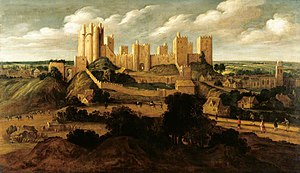February 14th is often given as the presumed date of the death - from whatever cause - of the deposed King Richard II in Pontefract Castle in 1400. As that event is one of the most famous in the history of the castle today seems an appropriate one on which to write something about the current state of its remains.
Pontefract Castle
A painting of about 1630 by Alexander Keirinx
Image: Pontefract Museum - WMDC/ Wikipedia
Almost a year ago I was answering a some questions from a researcher in the US about another prisoner held at the caste, Charles Duke of Orleans, who was captured at Agincourt. As I was writing my reply I was looking online for suitable pictures to illustrate it and realised how much better the castle looks now than it did when I lived in the town. It actually looks like a scheduled monument and not the curious mixture of somewhat neglected and fragmented ruins, still partly buried in demolition rubble from 1649, Victorian landscaping, public gardens and general open space that I knew and sought to understand and interpret.
As I thought about the evidence I saw it struck me that I can claim some part in initiating the positive changes that have taken place.
Pontefract Cadtle is still owned by the Duchy of Lancaster but has been leased to the local authority since the 1880s, when some excavations were carried out. English Heritage has oversight of care of the historic remains. In practice this meant that it was never easy to get significant work done as there appeared to be no-one in a position to give a clear response or authorise the appropriate expenditure. How to get something, anything, done was seemingly an impossible question to answer.
I frequently showed parties as well as friends round the remains, had taken part in some archaeological work there as a boy in 1962 and 1963, and later was to write two guide leaflets to the castle. The 1963 excavation yielded really important foundations of the outwork on the northern side, but they were promptly back filled. Involvement with all this made one feel that the site was definitely not being cared for as it might, and wished that the well intentioned lease to the borough in the 1880s had not been followed up by transferring the management of the ruins to what is now English Heritage.
This then was a historic site which was the setting for dramatic events for centuries, and an archaeological site that craved investigation. Something had to be done, but who was going to do it?
So, on my own initiative, in 1976 I wrote a report setting out the problems relating to the site and outlying possible excavation and conservation projects. This was then sent to anyone and everyone who might have responsibility for the site or who could raise awareness of the matter. I even ended up being filmed at the castle and televised on the BBC Look North programme. Nothing much ensued.
A while later the County Archaeologist had funds, a workforce and time to do something, and recalled my report. He looked at it and as a result set in motion excavation of the basement of one tower and work to de-clutter the exposed remains, to lay it out much more as an ancient monument, to consolidate the remaining walls. Further excavations have taken place and studies of the associated buildings. It is now a managed monument, not a rockery in a public park. The latest newsletter about the castle can be seen at PC-August2020/enewsletter.
A previous one from 2017 gives more details about the conservation work and the associated uncovering of original features, and can be seen at Exciting discovery at Pontefract Castle
The base of the Keep or Round Tower dating to the fourteenth century and encircling the outer side of the Norman motte. This is the structure on the left of the Keirinx painting.
Image: Yorkshire.com
There is an impressive visual display of reconstructions of the appearance of the medieval building together with archive material at Pontefract-Castle-A-Journey-Back-In-Time
A few weeks ago on the website of the Katherine Swynford Society I was delighted to find a video about three archaeologists digging out the drawbridge pit in front of the main gate to the inner bailey - the twin towered gateway at the centre of the Keirinx painting. This is exactly the sort of work I wanted to see done all those years ago, The video can be seen at Timeline | Pontefract Castle
Excavations will not tell us how King Richard II died but they will show us what he and so many others saw, lived, and died, in.
The Wikipedia entry on the castle - which is not entirely accurate in a few matters - outlines the most recent phases of conservation and provision of new facilities, and the delays involved. It can be seen at Pontefract Castle. The fact that it was on the “Heritage at Risk” list until 2019 indicates that things were seriously awry.
Much more still needs to be done, but a significant corner has been turned. For that, in all humility, I can, I think, claim some of the credit. Forty five years on it is still not as I would have wished in 1976 but real and significant progress has been made through local and national agencies. Setting that process in motion is one of my few claims to fame.




No comments:
Post a Comment